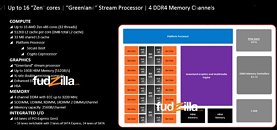Monday, April 13th 2015

AMD "Zen" A Monolithic Core Design
AMD's upcoming "Zen" architecture will see a major change in the way the company designs its CPU cores. It will be a departure from the "module" core design introduced with "Bulldozer," in which two cores with shared resources constitute the indivisible unit of a multi-core processor. A "Zen" core will have dedicated resources in a way things used to be before "Bulldozer," and only the last-level cache (L3 cache), will be shared between cores. "Zen" will also implement SMT, much in the same way as Intel processors do, with HyperThreading Technology.
The first implementation of "Zen" will be an insanely powerful APU (on paper anyway), featuring 16 physical "Zen" CPU cores, 32 logical CPUs enabled with SMT, 512 KB dedicated L2 cache per core, and 32 MB of shared L3 cache. The CPU's ISA instruction set will see a spring-cleaning, with the removal of underused instruction-sets, and the introduction of new ones. Other features on this APU are equally surprising - a quad-channel DDR4 integrated memory controller, a separate HBM (high-bandwidth memory) controller dedicated to the integrated graphics, with up to 512 GB/s bandwidth, and an integrated graphics core featuring "Greenland-class" stream processors. Given that AMD is able to build 7-billion transistor GPUs on existing 28 nm processes, building an APU with these chops doesn't sound far-fetched. The company could still have to rely on a newer fab.
Source:
FudZilla
The first implementation of "Zen" will be an insanely powerful APU (on paper anyway), featuring 16 physical "Zen" CPU cores, 32 logical CPUs enabled with SMT, 512 KB dedicated L2 cache per core, and 32 MB of shared L3 cache. The CPU's ISA instruction set will see a spring-cleaning, with the removal of underused instruction-sets, and the introduction of new ones. Other features on this APU are equally surprising - a quad-channel DDR4 integrated memory controller, a separate HBM (high-bandwidth memory) controller dedicated to the integrated graphics, with up to 512 GB/s bandwidth, and an integrated graphics core featuring "Greenland-class" stream processors. Given that AMD is able to build 7-billion transistor GPUs on existing 28 nm processes, building an APU with these chops doesn't sound far-fetched. The company could still have to rely on a newer fab.

102 Comments on AMD "Zen" A Monolithic Core Design
BUT!!! I will remain skeptical until released... We all know what happened with Bulldozer :ohwell:
None the less I'm still exited for AMD's R9 390 series GPU's & their Zen platform, I just hope they finally get some profiteering flowing :rockout:
Holy crap I do believe handbrake just got aroused.
There's a lot to like here and the huge news maker isn't the 16 cores, it's an integrated GPU with...an unbelievable...16 GB of memory on the same die. Too...unbelievable... If true though, that is one very, very serious APU in a very small package. It has next-gen consoles and Steam boxes written all over it.No, 16 physical cores and 16 logical cores for a total of 32 threads at once.
Maybe this is AMD's ticket for coming back to the high-end market. Let's hope there will be a HEDT version (ie. no integrated graphics) to compete with the 2011v3 platform.
My main rig used to be primarily AMD based, but switched to Intel since 1st gen i series. There is still a Phenom II X4 box remaining. Will upgrade this one if Zen delivers.
Given that the CMT-module architecture begun with BD was aimed squarely at the server market which AMD triumphantly (and prematurely) touted as architecture to take x86 enterprise market share off Intel...which in reality led to AMD's market share plummeting to 1.5%, it would seem that it was more than a few fanboys that killed the architecture. When AMD themselves are on record as stating that the architecture was an unmitigated failure, it's a little hard to lay the blame at the feet of a few forum posters don't you think?Could be feasible - CPU + 8 or 16GB of HBM RAM on interposer could be a potent package. AMD could shave off the unnecessary logic ( the DDR4 controllers would surely be aimed at server only since HBM couldn't provide the density for enterprise deployment).
I just merely pointed out that AMD gave us real cores within a module but the definition of a "core" often came into question from certain groups of negative people. Now they remove the modules and guys like gaximod still complain and throw the "real men use cores" statement in their faces. This is my own personal observation. I doubt AMD cared enough to make refinements based on this observation.
Their decision with this new architecture is likely because it meets their business needs only.
wccftech.com/amd-x86-zen-based-highperformance-apu-detailed-rumored-feature-16-cores-16-gb-hbm-memory-greenland-igpu-ddr4-memory-support/
I love AMD as much as the next guy and want them to be profitable but making people believe this is real based on rumors is just not good for the company (and coming from Fudzilla I have no doubt that could very well be part of the reason why they posted this). This could end up worse than the Bulldozer fiasco.
You have to use the hi-end water cooler for CPU TDP 300w, there aren't any air cooler can handle it now.
The 16 core variant is likely for server use. The commercial processors will likely be 2/4/8 core solutions.
So for a normal four core CPU it will be 300/4 = 75W which is VERY low for a four core processor with integrated GPU in its first revision.
Zen is a rumored architecture and anything printed is purely speculation for now.
I'd love to see an AMD CPU/APU kick Intel's butt once more like they did a decade ago.
Let's hope this really delivers this time.